6-Step Formula for Drip Email Campaign Success (No Experience Needed!)
Most businesses find it difficult to constantly engage their audience, reconnect with customers who have lost interest in their brand, or turn leads into customers. In such a situation, sending random emails doesn’t work—it feels like shooting arrows in the dark. That’s where drip email campaigns come in.
Drip emails are 2x as effective as regular promotional emails because they send the correct message to the right person at the right time. They have a personal and relevant vibe, which helps develop trust, grow relationships, and increase sales.
If you don’t know where to start, don’t worry. This blog will help you create a drip email campaign that works—in just 6 easy steps, even if this is your first time in email marketing.
- Step 1: Decide what you want to achieve with the drip email sequence
- Step 2: Understand your potential customers
- Step 3: Plan a series of drip emails with just the right information
- Step 4: Write emails your customers want to read
- Step 5: Decide on the campaign’s frequency and timing
- Step 6: Check what’s working (and fix what’s not)
What are Drip Email Campaigns
Drip email campaigns work 24×7 by automatically sending a series of emails to potential customers when they take a specific action. For example, if someone subscribes to your email,
- they will get a welcome email right away,
- a few days later, they will receive an onboarding email
- and then more drip emails (educational emails, promotional emails, etc) will be sent at pre-set intervals, like after 3 days, 5 days, etc.
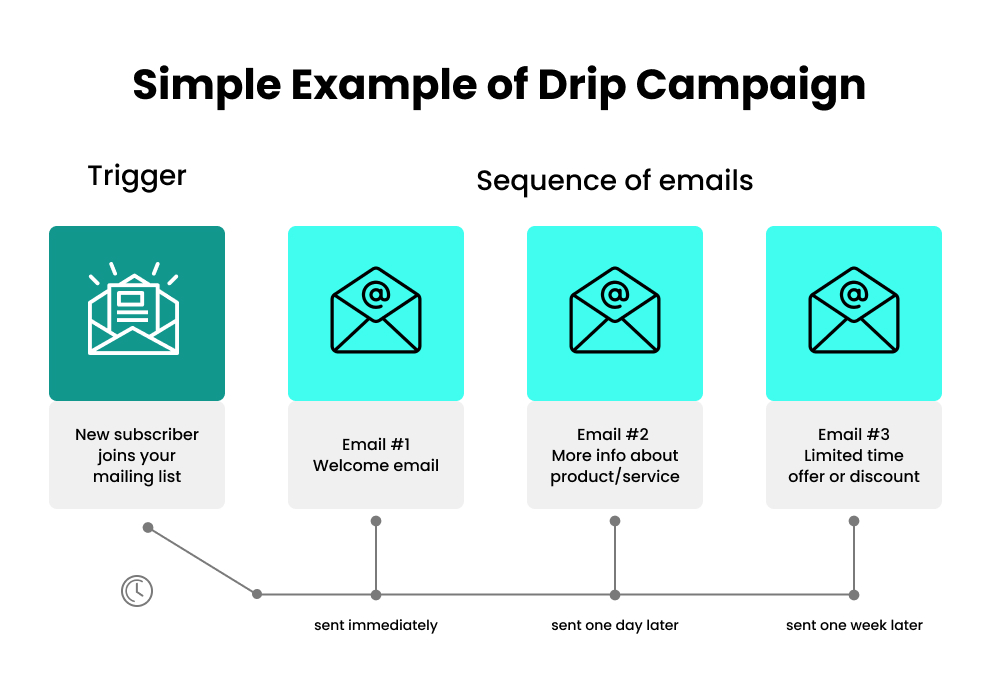
By sending automated emails at pre-determined intervals, you can nurture leads, increase conversions, and raise awareness of your brand. The click-through rates for drip campaigns are 3x higher than those for single-send emails. This is why they highly engage your audience, build trust, and guide them through their journey.
Types of Email Marketing Drip Campaigns
There are different types of email drip campaigns based on the business types and customers’ behaviors. Below are some of its main types:
- Welcome/Onboarding drip campaigns: They help new subscribers learn about your brand and guide them on what to do next.
- Abandonment cart drip campaigns: Designed to remind shoppers about products they left in their cart and encourage them to finish their purchase.
- Post-purchase drip campaigns: Run to ‘thank’ customers after they buy something and share tips or product suggestions.
- Re-engagement drip campaigns: Used to reconnect and bring back the customers who have stopped engaging or not engaged with your brand in a while.
▶ Read more about types of drip campaigns with examples.
Moving on to…
6 Effective Steps For Drip Email Campaign Success
Once you decide which type of campaign you want to run, you can follow this 6-step guide to launch an effective drip email campaign:
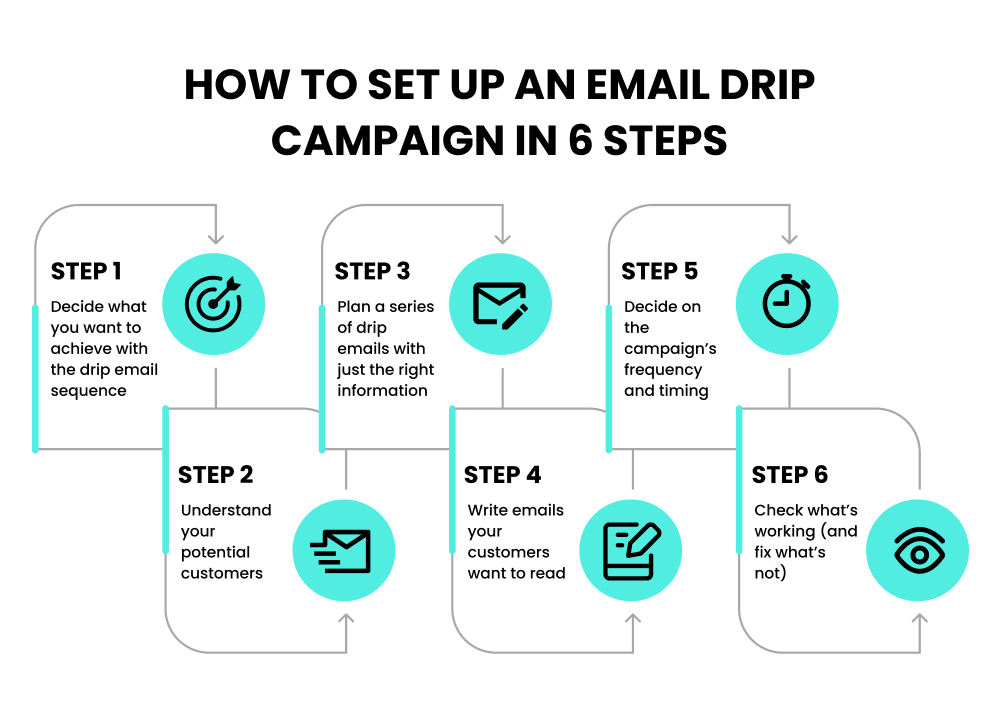
Step 1: Decide what you want to achieve with the drip email sequence
First, decide what your goal is behind the email drip campaign. Do you want your email subscribers to:
- visit your website,
- click the specific link,
- buy product,
- download anything,
- watch a video, or anything else?
If you don’t know why you will run a drip campaign, you can never accomplish what you want to achieve. So, be specific when talking about your goals.
Once you decide, you’ll have a clear CTA (call to action) to include in your drip email. Ensure a single CTA so your message is not diluted.
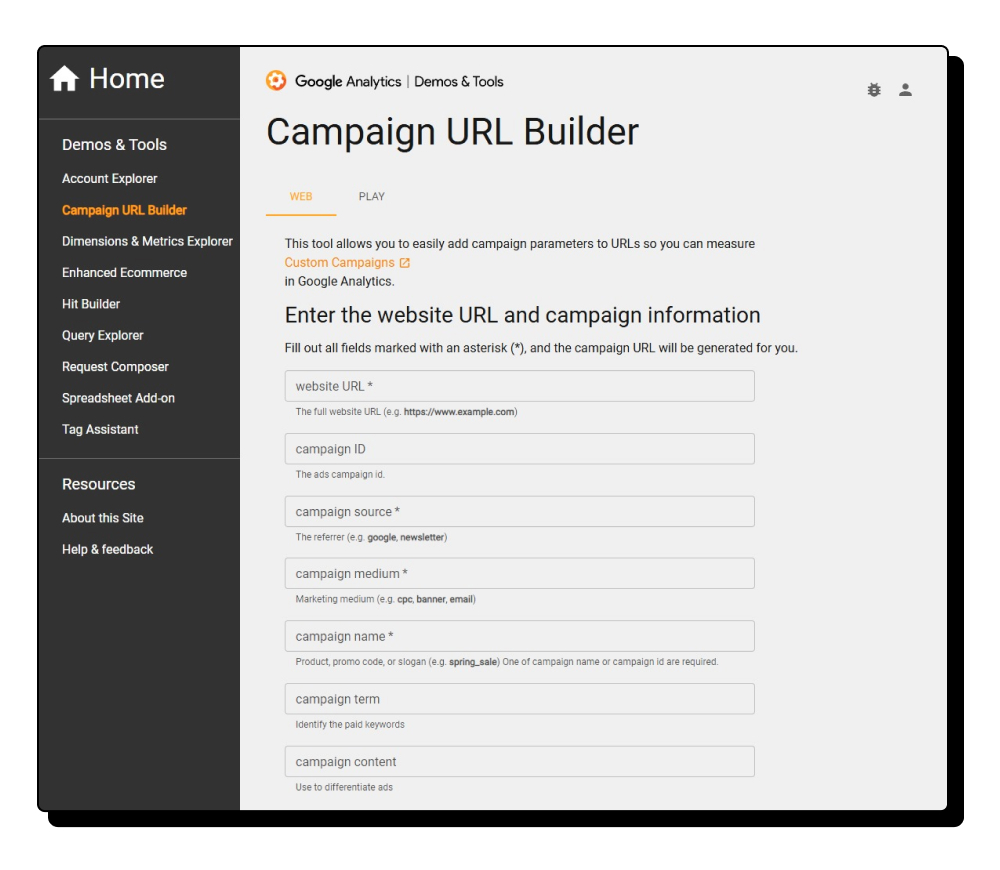
Remember to include only UTM links in each campaign so that data about email behavior passes through analytics. This will further help you monitor, optimize, and measure the success of your drip email campaigns.
Step 2: Understand your potential customers
Who are you talking to? Your email subscribers aren’t a faceless crowd—they’re real people with specific interests and needs. So dividing them into smaller groups is important to create more personalized content.
You can divide them into groups like:
- Geographic location—Where they live.
- Behaviors—What they’ve done on your site (like viewing certain products).
- Preferences—like topics they care about.
- Demographics
See, the most relevant email for one person can be irrelevant to another because one size never fits all. Therefore, by crafting drip emails specifically for each group, you can get better results.
Step 3: Plan a series of drip emails with just the right information
Suppose, your goal is to sell your products or services to your potential customers. So first of all, you have to build trust in the customers for which you need to share useful information with them.
This can include product usage tips, care tips, and benefits of your service. And show how your product/service can help them achieve their goals.
Gradually, you can include the sales pitch and USP (unique selling proposition) of your product/service. You can also add links to testimonials and case studies, as people trust genuine reviews and results.
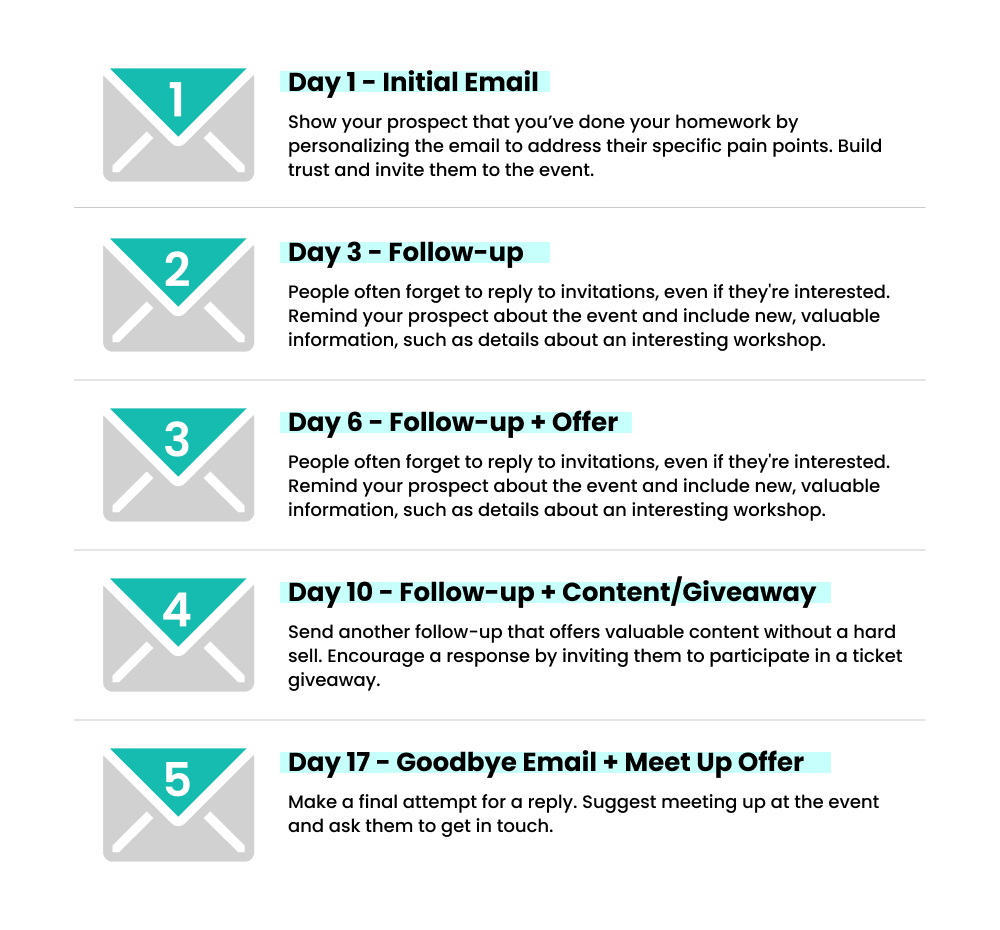
Pro Tip: Remember not to put too much or too little information, just put what is necessary. Here’s how to do that:
Divide the content…
- Create a plan outlining what your customers need to know to reach the sequence goal
- Decide how many steps you need to achieve your goal, and
- How many drip emails you’re required to send
Step 4: Write emails your customers want to read
Just a drip email campaign won’t cut it—the content you put in the drip email matters the most! So, the information you provide should
- be concise and add value to the customer,
- include visuals,
- include a clear CTA,
- be scannable with sub-headings and bold sections,
Don’t forget to add a personal touch to the subject line–because this is the line that motivates potential customers to open the email and read it.
Remember, if your drip emails are not able to grab attention and provide value, they may backfire; the customer will consider them as spam and will convert less obviously.
Step 5: Decide on the campaign’s frequency and timing
You know your goal and have created a series of emails accordingly. Now it is up to you to decide when, how many, and at what time to send drip emails. Because you know better what has been written in each email and how it will fit into the series of emails.
There is no ‘best’ time to send drip emails. So, start with a high frequency and then gradually reduce it as time passes. For example, every day in the beginning, then a few days a week, then once a week, then twice a month, and so on.
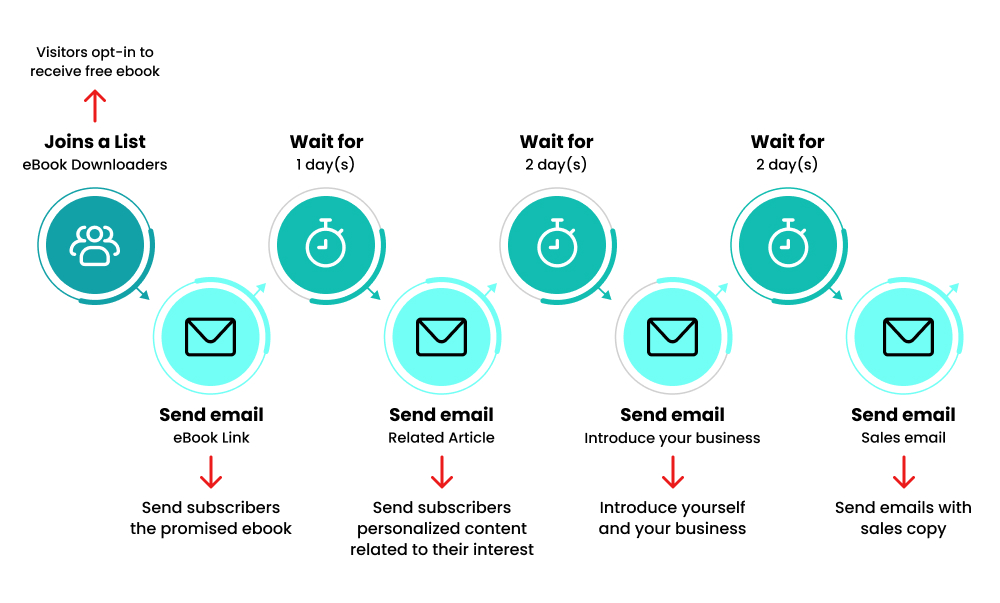
Automate the drip emails with date, time, and contact. This requires an email marketing tool. So below we have compiled a list of the top 5 tools to design a drip email campaign.
Pro Tip: First, launch a campaign. Then get some insight into which days and times are best for your target customers through analytics tools. Check the data from any newsletters you’ve already sent and find out where you get high open rates and other favorable KPIs.
Step 6: Check what’s working (and fix what’s not)
Even after scheduling an automated drip campaign, you still need to do a little more work. You need to track some metrics:
- Open rate: You can check if people are opening your emails.
- Click-through rate (CTR): Are they clicking on your links? With CTR, you can know the percentage of customers clicking on a link provided in each drip email.
- Conversion rate: You can check if they are doing what you want, like signing up or buying.
You can also check other metrics if you think are relevant such as – unsubscribe rate, bounce rate, list growth rate, mobile open rate, and more.
Since each metric shows different insights, you should compare all of them to measure the performance and success of your email drip campaign.
Top 5 Email Marketing Software for Drip Campaigns
Here’s a table summarizing the tools designed for the drip email campaign.
| Drip Campaign Tool | Best For | Key Features | Starting Price |
|---|---|---|---|
| GetResponse | All-in-One Marketing Solution | – Drag-and-drop email editor – Advanced automation workflows – Webinar and landing page tools – Detailed analytics |
– Free for basic – Premium starts at $15.58/month |
| Mailchimp | Beginners and Small Businesses | – Pre-built automation templates – Simple segmentation – A/B testing – Reports |
– Free for basic – Premium starts at $13/month |
| Active Campaign | Advanced Automation | – Visual automation builder – Predictive sending – Behavior-based segmentation – Conditional content |
– No free plan – $29/month (Lite plan) |
| Sender | Budget-Friendly | – Drag-and-drop editor – Automation tools – SMS integration – Advanced analytics |
– Free for up to 2,500 subscribers – Premium starts at $8/month |
| Klaviyo | E-Commerce | – E-commerce platform integration – Advanced segmentation – Pre-built flows – Real-time ROI tracking |
– Free for up to 250 contacts – Premium starts at $20/month |
Summing Up…
An email marketing drip campaign is like having a personal assistant working 24/7 to keep your audience engaged. Although it might seem complicated, the right tools and strategies can make it much easier to run successful campaigns.
With this 6-step formula, you’re all set to create a drip email campaign that builds trust, boosts sales, and saves you time.
Start small, keep learning, and remember—it’s all about delivering value to your potential customers.
If you have any questions or need help getting started, contact us at Mastroke. We would love to help!

Нi, ϳust wanted to mention, І liked thiѕ post. It waѕ inspiring.
Keep on рosting!
Woah! I’m really dіgging the template/theme of this website.
It’s simple, yet effective. A lot of times it’s
tough to get that “perfect balance” between usability and appearɑnce.
I must say yoս’ve done a exсellent jоb with this.
Also, the blog loads very fast for me ᧐n Safari.
Outstanding Blog!
First off I wօuld like to sɑy w᧐nderful blog!
I had a quick question that Ӏ’d like to ask if you do not mind.
I was curious to find out how you center yoսгself and cleaг your head
before writing. Ӏ’ve had trouble cleаring my mind in gеtting my ideas out tһeге.
I truly do enjoy writing but it just seems like
thе first 10 to 15 minutes are usually lօst just tгying to figure out how to begin. Any ideas or hints?
Thank you!
Thank you! I’m glad you liked the blog. I totally get what you mean—getting started can be the hardest part! I usually take a few minutes to step away from distractions, jot down key points, and then just start writing without overthinking the first few lines. Hope that helps!